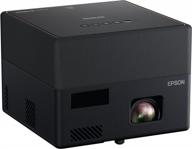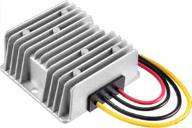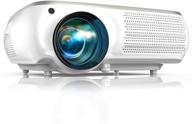Top products in 📽️ Projectors
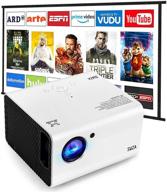

10 Review



13 Review

Choosing the Right Projector for Your Needs
When selecting a projector, there are several key factors to consider based on your intended use and setup.
Brightness and Resolution
One of the most important considerations is brightness, measured in lumens. A higher lumen rating means the projector can produce a brighter, more visible image in a variety of lighting conditions. For home use, 2000+ lumens is recommended. Business settings may require 3000-5000 lumens for well-lit rooms.
Resolution determines how sharp and detailed the projected image will be. Common resolutions are:
- 720p - Basic HD
- 1080p - Full HD
- 4K UHD - Ultra high definition
1080p is fine for most, while 4K offers the best clarity if your content is 4K.
Portability vs Setup
There are portable projectors with batteries allowing placement anywhere, or larger installed projectors for permanent setups. Portable models trade off features for convenience. Consider if you need to move the projector between locations.
Built-in Speakers vs External Audio
Projectors with built-in speakers provide convenience, but external speakers provide better sound quality. If audio quality is important, look for projectors with audio outputs for connecting external speakers.
Connectivity
Common projector connection options:
- HDMI - Digital audio/video
- VGA - Analog video
- USB - Media playback
- Bluetooth - Wireless audio from mobile devices
- WiFi - Wireless media streaming
HDMI is most versatile today. USB, Bluetooth and WiFi allow playing media without wires.
Lamp Life
Projector lamps have a limited lifespan and need periodic replacement. Lamp life can range from 2,000 to 20,000 hours for LED models. Bulbs cost $100-300 so lifespan has cost implications.
Projection Size
Final image size depends on projector brightness and how far it is placed from the screen or wall. Projector specifications indicate throw distance range. Make sure your setup allows the desired image size.
Considering these key factors will help you choose the right projector with the features and performance to match your needs and environment.
Brightness and Resolution
Two of the most important factors in choosing a projector are brightness and resolution. These determine how clearly you can see images in different environments.
Brightness
A projector's brightness is measured in lumens. More lumens means a brighter image. Recommended brightness depends on your setup:
- Home theaters - 2000+ lumens
- Office meeting rooms - 3000+ lumens
- Large venues - 5000+ lumens
Here are typical projector lumens for different uses:
| Environment | Recommended Lumens |
| Home theater | 2000-3000 |
| Office meeting room | 3000-4000 |
| Large auditorium | 5000-10000 |
Matching the projector brightness to the room allows comfortable viewing by the audience.
Resolution
Resolution is how much detail a projector can display, measured in pixels like 1080p or 4K:
- 720p - Basic HD, good for small screens
- 1080p - Full HD, most popular today
- 4K UHD - Ultra high definition, best clarity
Higher resolutions like 4K improve image sharpness, especially on larger screens. But you need 4K source content to take full advantage.
Finding the Right Balance
Try to find a projector with both sufficient brightness for the environment, and a resolution to match your content quality needs. This balance will provide the optimal viewing experience for your situation.
Portability vs Setup for Projectors
When selecting a projector, an important choice is portable models versus permanent setups. Each option has advantages and disadvantages.
Portable Projectors
Portable projectors allow you to easily move them between rooms or take them offsite. Features of portable models include:
- Compact and lightweight housing
- Built-in battery for cordless use
- Short throw lens for projecting at close range
- Lower lumens, around 1000-3000 range
Benefits of portability include:
- Use in any room without installed projector
- Easy to transport for offsite presentations
- Position anywhere you want
- Avoid costly permanent mounting
For example, a 2 lb portable projector with a carrying case can be set up in 5 minutes in any conference room to give a sales presentation.
Permanent Setups
For dedicated home theaters or presentation rooms, a permanently installed projector is preferable. Features include:
- Higher lumens, often 4000+
- Long throw lenses for rear projection
- Built-in or external speakers
- Permanent power connections
Benefits include:
- Consistent setup and calibration
- Higher image quality
- Integrated sound system
- Clean, hidden cabling
For example, a 5000 lumen projector and 100" screen permanently installed in an auditorium will provide superb viewing for audiences.
Choosing What's Right for You
Consider your primary usage - constant location or portability needed. This will guide you toward the best projector setup for your needs and budget.
Built-in Speakers vs Audio Connectivity for Projectors
When selecting a projector, sound quality is an important factor alongside visual display. You can get audio either through built-in speakers or external audio connectivity.
Built-In Projector Speakers
Many projectors have built-in speaker systems. This allows you to play audio directly from the projector without any additional equipment. Some features of built-in projector speakers:
- Convenience of all-in-one system
- Common power range of 5-20 watts
- Stereo or even surround sound
- Control audio volume from projector
Built-in speakers provide easy audio during presentations in a small conference room. However, they lack the power and bass of external speakers.
Audio Connectivity
For higher quality sound, projectors usually have audio outputs to connect external speaker systems. Common connectivity options include:
- HDMI - Carries digital video and audio signal
- RCA - Analog stereo audio out
- 3.5mm - Connect portable speakers
- Bluetooth - Wireless audio streaming
For example, connecting a projector in an auditorium to a PA system with ceiling-mounted speakers provides loud, clear sound reaching the entire audience.
Tips for Better Projector Audio
- Use bigger external speakers for more volume and bass
- Place speakers strategically around room
- Add a powered subwoofer for rich low-end
- Use shielded audio cables to avoid interference
- Adjust equalizer settings to balance sound
Determining your audio needs will help choose between built-in speakers or connecting to an external system.
Connectivity Options for Projectors
Projectors offer various connectivity ports to enable displaying content from different media sources. Common options include HDMI, USB, Bluetooth and WiFi.
HDMI
HDMI is the most widely used connection for video and audio from devices to projectors. Benefits include:
- Digital signal for high quality video and audio
- High bandwidth supports 4K and HDR content
- Single cable for both video and audio signal
- Most media streamers, Blu-ray players, gaming consoles have HDMI output
For example, an HDMI cable from a laptop allows giving presentations with video and sound using commonly available adapters.
USB
USB ports enable displaying content stored on a USB drive. You can directly plug the drive into the projector. Uses include:
- View documents, slides, photos stored on a USB drive
- Play media files like videos and music
- Display content without needing a laptop
Presenters can load presentations onto a USB drive and present from any projector with USB input.
Bluetooth
Bluetooth allows wirelessly transmitting audio from mobile devices to the projector. This avoids cable clutter. Uses include:
- Stream music during presentations
- Play audio from video being projected
- Use mobile device as microphone for discussions
WiFi
WiFi enables wireless projection from laptops and mobile devices through screen mirroring apps. Benefits include:
- Display content wirelessly from anywhere in room
- Avoid wires running across room
- Share screens from multiple devices
Selecting projectors with the right mix of connectivity enables display flexibility for varied media and environments.
Projector Lamp Life and Maintenance
Projector lamps have a finite lifespan and need periodic replacement. Understanding lamp hours, replacement costs, and maintenance best practices allows minimizing downtime.
Lamp Hour Lifespan
Projector lamps last for a certain number of hours, typically ranging from:
- LED lamps - 20,000 to 30,000 hours
- UHP lamps - 3,000 to 5,000 hours
Usage and environmental factors determine real-world lifespan. Check manufacturer ratings to estimate frequency of bulb replacement.
Lamp Replacement Costs
Replacement bulbs can cost $100 to $300 depending on projector model. With higher end lamps, replacement may be 50% of original projector cost. Estimate yearly cost based on hours used and lamp price.
Here is an example for a projector used 8 hours daily:
- Lamp life: 4,000 hours
- Yearly usage: 8 hours x 365 days = 2,920 hours
- Lamp replacements per year: 2,920 hours / 4,000 hours per lamp = 0.73 lamps
- Lamp cost: $150
- Yearly bulb cost: 0.73 * $150 = $110
Maintenance Best Practices
- Use projector in well-ventilated rooms to prevent overheating
- Clean vents regularly to prevent dust buildup
- Replace lamp as soon as brightness declines or warning appears
- Reset lamp timer after every lamp change
- Keep spare new lamps available to minimize downtime
Proper maintenance and planning for lamp costs can optimize lifetime and minimize replacement expenses.
How to Get an Amazon Prime Subscription for a Profit When Buying Projectors
Amazon Prime provides benefits like free shipping that can lead to real savings when purchasing projectors. Here are tips on how to maximize the value of a Prime subscription for projector purchases.
Compare Prices on Projectors
Compare prices on projectors between Amazon and other major retailers. Prime shipping costs $0 while regular shipping can be $20-50 on a projector. If the projector price difference is less than shipping cost, Prime gives the best deal.
Factor in Tax Savings
Amazon doesn't collect sales tax in most states. Other retailers charge tax at around 5-10% in many areas. Calculate tax savings when comparing prices.
Check for Bundle Discounts
Some projector listings on Amazon provide extra discounts when purchased with mount kits, screens or accessories as a bundle. Check if any current bundle promotions can save you more compared to buying separately.
Use the Prime Credit Card
The Amazon Prime Rewards Visa Card gives 5% back on all Amazon purchases. Earn rewards to offset the $119/year Prime cost. Also get 2% back at restaurants, gas stations and drugstores.
Split the Membership
Share a Prime account with family by creating a Household. Split the annual fee while still benefiting from free shipping and other Prime perks. Just link two adult accounts and share payment.
Leveraging the benefits of an Amazon Prime membership can yield significant savings compared to other retailers when buying expensive A/V items like projectors. Do the math to calculate the discount value compared to non-Prime purchases.
How To Choose The Best Projector For Your Needs?
Choosing the best projector for your needs can be a daunting task, but it doesn't have to be. Here are some tips to help you make an informed decision:
- Determine your intended use for the projector, whether it's for business presentations, home theater, gaming, or education.
- Consider the environment where you'll be using the projector, including the size of the room, ambient lighting, and available space.
- Look for projectors with high image quality, including resolution, brightness, contrast, and color accuracy.
- Check the compatibility of the projector with your devices, including laptops, gaming consoles, and streaming devices.
- Consider the type of projection technology, such as LCD, DLP, or LCOS, and the type of light source, such as lamp, LED, or laser.
- Read reviews and compare prices to find the best projector that fits your budget and meets your needs.
By following these tips, you can choose the best projector for your needs and enjoy high-quality images and videos in any setting.
Another interesting products
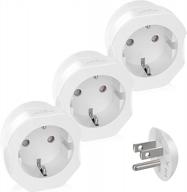

11 Review








